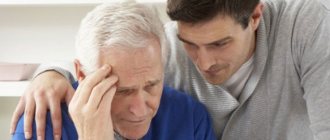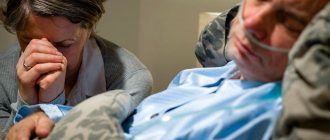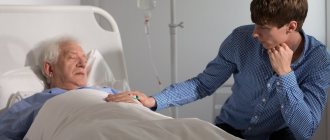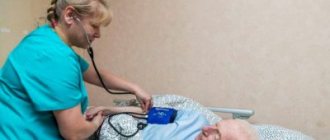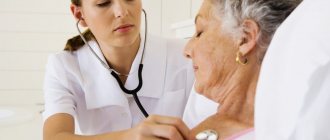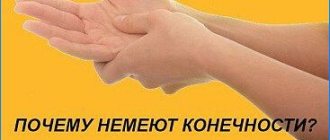From this article you will learn:
- What are the causes of ischemic stroke in older people?
- What are the types of ischemic stroke in older people?
- What are the symptoms of ischemic stroke in older people?
- What are the consequences of ischemic stroke in older people?
- How to treat elderly people with ischemic stroke for elderly people
In older people, the elasticity of blood vessels noticeably decreases, atherosclerotic plaques and blood clots begin to appear, and persistent spasms occur. All this impedes blood flow, causing blockage of blood vessels and provoking the development of a stroke. The disease is manifested by deviations in usual actions: the arm and leg on one side of the body weaken, the symmetry of the face, facial expressions, speech, vision, and coordination of movements are disrupted. A person cannot smile, pronounce words clearly, raise his hands; changes and even loss of consciousness are possible. Everyone needs to know these signs of illness. We will talk about what else is accompanied by ischemic stroke in older people in our article.
Causes of ischemic stroke in older people
The main blood vessels that provide blood flow to brain cells (carotid, vertebral arteries) are called cerebral. If their patency is impaired, a cerebral infarction (ischemic stroke) develops. The cause may be a detachment of a blood clot, an increase in atherosclerotic plaque, or persistent vasospasm. When a blockage occurs, brain cells no longer receive enough oxygen and nutrients, causing irreversible tissue changes in that area.
The frequent manifestation of ischemic stroke in older people is associated with age-related organic changes in the walls of blood vessels, their compaction, and the deposition of cholesterol on them. Regular circulatory disorders in the body associated with other diseases and pathologies also have an effect:
- atherosclerosis of coronary vessels, peripheral arteries;
- obesity;
- hypertension and secondary hypertension;
- hereditary predisposition;
- metabolic syndrome;
- diabetes;
- lipid metabolism disorder (dyslipidemia);
- nicotine addiction;
- chronic alcoholism.
Disorders of cerebral hemodynamics can be provoked by a sedentary lifestyle, consumption of large amounts of fatty meat products and sweets, and frequent stressful situations.
We recommend
“Stroke in an old person: causes and consequences” More details
With age, the risk of ischemic stroke in older people increases; after 55 years, it is more common than hemorrhagic. Rupture of cerebral vessels and hemorrhage occur mainly in persons suffering from prolonged arterial hypertension, atherosclerotic artery disease, and amyloidosis. Uncontrolled use of drugs that prevent blood clotting can also cause hemorrhagic stroke.
Among the potential victims of vascular pathology of the brain, most of them are those who suffer from diabetes. This connection has its own explanations. :
- angiopathy (changes in the thickness of the walls of blood vessels) develops against the background of increased glucose levels in the blood;
- due to constant efforts aimed at removing glucose and fluid from the body, dehydration occurs and the blood thickens;
- tissues chronically lack nutrients, because due to a lack of insulin, glucose does not enter the cells;
- Against the background of diabetes, it is difficult for the body to form bypass pathways to restore blood supply to the affected area.
The excessive obesity of many diabetics is associated with a violation of not only carbohydrate but also fat metabolism. Insulin deficiency leads to increased cholesterol levels in the blood, which, in turn, causes the early manifestation of atherosclerosis, which is quite severe.
Hence the prevalence of extensive forms of ischemic cerebral infarction in older people, accompanied by complications and frequent death.
Types of ischemic stroke in older people
Acute ischemic cerebrovascular accident has several stages. Each develops in its own way and has its own characteristics.
1. Acute stroke.
It is considered the initial period of development of ischemic stroke and lasts no more than 21 days. Pathogenetic changes in brain tissue occur especially quickly during the first 6 hours of illness. In 5–7 minutes, a nucleus is formed from damaged cells; after an hour and a half, the penumbra around it increases by 50%, and after 6 hours – by 80%.
If the necessary medical care is provided in the first 6 hours, the ischemic cerebral infarction will pass, leaving almost no serious negative consequences for older people. Since as a result of pathogenetic processes, brain cells begin to die from the first minutes, if treatment does not start on time, apoptosis will spread exponentially. And after 3–5 days, necrosis of the damaged cells will occur.
Intensive therapy during the first 6 hours includes:
- improving blood supply to brain tissue;
- protecting cells from destruction;
- improving viscosity, coagulability and microcirculation of blood in the smallest vessels of the brain;
- prevention of cerebral edema.
In addition to acute, there are other, more complex types of brain disorders.
2. Major stroke.
Large vessels supplying blood to the brain are susceptible to extensive ischemic stroke. A condition in which many small areas of brain tissue or, conversely, a large fragment is affected, is also considered a major stroke. This is a serious disease with obvious symptoms of brain damage in older people:
- depression of consciousness;
- cerebral edema;
- hemiparesis or hemiplegia on the opposite side of the lesion;
- paresis of gaze towards paralyzed limbs;
- disorder of consciousness;
- autonomic disorders;
- trophic disorders.
The manifestation of certain symptoms is affected by the location of the damaged hemisphere - on the right or on the left. A common sign of ischemic stroke in older people is deep fainting, during which you should carefully look at the patient’s pupils, shining a light directly into his eyes. If the pupils do not react to light and do not dilate, then perhaps a massive stroke is beginning. An elderly patient can only be saved by urgent hospitalization in the intensive care unit, where he will be connected to a life support system.
3. Lacunar stroke.
The most common type of cerebral vascular pathology is lacunar. But it can only be determined in a hospital, albeit in the very early stages. A lacunar stroke damages the deep layers of brain tissue, resulting in the appearance of cavities (lacunae) with a diameter of 1 to 15 mm. Small lacunae, merging, form larger ones, and blood or plasma and fibrin can already accumulate in them.
The development of lacunar ischemic stroke does not impair vision, speech, consciousness, or other functions of the cerebral cortex, since all pathological processes occur deeper. There are no symptoms of brain stem damage. Such differences distinguish this type of stroke from other types of disease.
Recommended articles on this topic:
- How to prevent stroke using folk and medical remedies
- Brain medications for older people: top 10 best drugs
- Caring for older people after a stroke: features, rules and recommendations
Sudden jumps in blood pressure can trigger the occurrence of lacunar ischemic cerebral infarction in older people. Therefore, at risk are those patients who have the following pathologies:
- hyaline dystrophy AG;
- atherosclerosis;
- infectious inflammation of arterioles;
- diabetes;
- vasculitis.
The consequences of lacunar ischemic stroke in older people are very sad: memory loss, impaired spatial orientation, deep depression, and subsequently dementia.
Risk of recurrent stroke
Mortality after an ischemic stroke is 20% during the first month and about 25% during the first year.
More than half of the surviving patients have a second stroke over the next 5 years, with most cases occurring in the first year.
In Russia, on average, about 100 thousand recurrent strokes are registered annually. Six months after a stroke, disability occurs in 40% of surviving patients.
During the first 5 years, up to 85% of patients die or remain disabled and only the remaining 15% of patients manage to recover.
Symptoms of ischemic stroke in older people
Most often, ischemic cerebral infarction occurs at rest or even during sleep. The process develops gradually, more slowly than with the hemorrhagic form, but it still begins unexpectedly, and the manifestations progress quickly.
Since cell damage occurs in separate areas of the cerebral cortex, symptoms arise in the form of focal disorders.
Clinical manifestations of blockage or spasm of the carotid arteries:
- reduction (paresis) or complete loss (paralysis) of the ability to move limbs on one side of the body;
- pathological muscle tone and reflexes;
- paresis of facial muscles - impaired facial expressions, immobilization of half the face, distortion, inability to smile evenly, raise eyebrows, smoothness of the nasolabial fold, drooping of the corner of the eye, lips;
- loss of sensitivity in the affected limbs;
- blurred vision, flashes of light, visual hallucinations;
- slurred speech;
- inability to act purposefully (apraxia);
- violation of the eye, difficulty determining the distance to objects, their relative position;
- emotional and mental disorders.
Signs of ischemic stroke in older people that cause reasonable concern:
- sudden numbness of the limbs or any other part of the body;
- loss of control over one’s body – it is difficult for an elderly person to understand what is happening to him or where he is;
- speech disorders (incoherent words, the victim does not understand what others are saying to him);
- blurred vision, the image in the eyes is double, the field of view is partially lost;
- a distorted face, the corners of the mouth droop; if you ask the victim to smile, he will not be able to do so;
- paralysis of any limb - it is impossible to raise an arm or leg, or move them;
- when the tongue sticks out of the mouth, it deviates from the middle to the side;
- general cerebral disorders - loss of consciousness, convulsions, nausea, vomiting, headache.
The consequences of the disease, which will subsequently affect a person’s standard of living, ability to work, and do without outside help, depend on the timely start of treatment. In most cases, older people who have suffered a stroke can no longer return to their normal lives; they develop vestibular disorders, paralysis, and speech changes.
Consequences
The brain is an extremely complex organ that controls various functions of the body. If blood cannot reach the areas of the brain that control the functions of certain parts of the body, those parts of the body will stop working properly.
After an ischemic stroke, people may experience:
- Movement problems, weakness or paralysis – this can lead to difficulty moving, walking and coordinating. Movement problems on one side of the body are called hemiparesis or hemiplegia.
- Swallowing disorder. Violation of the act of swallowing can lead to food and liquid entering not into the esophagus, but into the windpipe and lungs, thereby becoming the cause of severe pneumonia. Swallowing problems can also lead to constipation and dehydration.
- Speech Impairment. Impaired reproduction and understanding of speech, including difficulties in reading, writing, and counting, occur as a result of damage to the left hemisphere of the brain.
- Problems of perception. With normal vision, a person is not able to understand what he sees. Perceptual impairments make it difficult for a person to use everyday objects. For example, a person cannot take a glass and pour water into it and then drink it.
- Cognitive impairment. The ability to mentally perceive and process external information is impaired. Clear and logical thinking is impaired, memory deteriorates, and the ability to learn, make decisions and plan ahead is lost.
- Behavioral disorders. Aggression, delayed reactions, fearfulness, emotional instability, and disorganization may appear.
- Disorders of urination and defecation. Bowel or bladder difficulties (urinary incontinence or retention, fecal incontinence) can be caused by a number of different problems after a stroke.
- Psychological disorders. Sudden mood swings, depression, irritability, reasonless laughter or crying. Depression is a very common problem in people who have suffered a stroke and is often accompanied by loss of appetite, unreasonable laughter or crying, insomnia, low self-esteem and increased feelings of anxiety...
- Epilepsy develops in 7-20% of people who have had a stroke.
- Pain syndrome. After a stroke, a small number of people develop painful attacks in the form of burning, shooting, throbbing pains that are not relieved by painkillers.
Diagnosis of ischemic stroke in the elderly
Data from objective and instrumental research methods and their comprehensive competent assessment will help diagnose ischemic stroke in older people:
- neurological examination;
- Ultrasound examination of the arteries of the head and neck;
- computed and magnetic resonance imaging;
- angiography;
- transcranial Doppler ultrasound;
- electroencephalographic study.
Proper diagnosis will help distinguish ischemic stroke from hemorrhagic stroke. Neuroimaging techniques for studying the disease play an important role here. It is necessary to identify and differentiate between ischemic stroke and other brain diseases, for example, acute hypertensive encephalopathy. It is important to distinguish impaired brain activity due to blockage or spasm of blood vessels from toxic or metabolic types of encephalopathy, from brain tumors, abscesses, encephalitis and other brain lesions of an infectious nature.
Treatment of ischemic cerebral stroke in elderly people
Relatives of an elderly person who has suffered a cerebral infarction must understand that in a hospital setting, doctors will monitor the patient’s condition and will be able to provide him with the necessary therapeutic assistance in a timely manner. Patients in a state of deep coma with impairment of all vital functions will not be taken to a medical institution. Hospitalization will not help those who have repeated cerebrovascular accidents complicated by dementia and other mental disorders, as well as patients with incurable somatic diseases.
We recommend
“Care for bedridden patients after a stroke: how to achieve a quick recovery?”
More details Treatment of ischemic stroke follows certain rules:
- It is necessary to influence the activity of the cardiovascular system - with a pronounced decrease in myocardial contractility, cardiac glycosides are used, antihypertensive drugs, calcium antagonists (Nifedipine), beta blockers (Obzidan) and diuretics (Lasix), respiratory analeptics are administered (“Cordiamin”, “Sulphocamphocaine”).
- Correction of homeostasis is carried out by introducing electrolyte solutions (5% glucose solution, 0.9% sodium chloride solution, Ringer's solution, 4% sodium bicarbonate solution, polarizing mixture), low molecular weight dextrans (Reopoliglucin up to 400 ml), correction of hypokalemia, hypochloremia .
- To combat cerebral edema, 10 ml of 2.4% Euphyllin, 1 ml of Lasix, and, if necessary, Mannitol and urea are injected intravenously; antihistamines (Diphenhydramine, Pipolfen), novocaine; Hydrocortisone, dexamethasone, prednisolone, glycerin can be used orally.
This is how vegetative disorders are eliminated:
- at high temperatures, “lytic” mixtures are prescribed, including diphenhydramine, novocaine, analgin;
- neurovegetative blockade is carried out using droperidol, diphenhydramine, aminazine;
- It is advisable to rub the patient’s body with alcohol until red, which increases heat transfer;
- To reduce the temperature of large vessels, local cooling of the carotid arteries, axillary and groin areas is carried out, and wrapping with damp sheets is carried out.
In case of hemorrhagic stroke, blood clotting is increased and the permeability of the vascular wall is reduced using calcium preparations (10 ml of a 10% solution of calcium chloride intravenously or calcium gluconate intramuscularly), “Vikasol” (2 ml of 1%), 5–10 ml of a 3% solution of ascorbic acid, gelatin 10% – 20–50 ml intravenously, rutin, rutamin, e-aminocaproic acid (5% – up to 100 ml), “Ditsinon” (2 ml–250 mg) intravenously or intramuscularly; surgical treatment is possible - puncture stereotactic removal of the lateral hematoma after CT, various methods of surgical treatment of cerebral aneurysms.
Note that in case of ischemic stroke the following is done:
- increase blood flow to the brain by dilating regional cerebral vessels and reducing vasospasm, improving collateral circulation, using vasodilators (10 ml of 2.4% Eufillin solution intravenously), nicotinic acid (1% solution 1-2 ml intravenously), Stugeron ", "Trental" and others;
- improve venous outflow by administering cocarboxylase (50 mg) and Dietifen (10 mg);
- normalize blood coagulation and rheological properties with the help of heparin (5000–10000 units intravenously or intramuscularly for 3 days), “Phenilin” and other indirect anticoagulants (up to 2–3 months), acetylsalicylic acid, “Complamin”, “Prodectin”, "Trental" and others.
Increasing the resistance of brain tissue to low oxygen levels and improving brain metabolism is carried out through the use of tissue metabolism inhibitors (neuroleptics, regional hypothermia) ATP, vitamins and amino acids (cocarboxylase, glutamic acid, glycine, B vitamins, vitamin E), nootropics (Aminalon ", "Piracetam"), "Cerebrolysin", "Actovegin", hyperbaric oxygenation.
An elderly patient with ischemic stroke should be under constant monitoring, so it is necessary:
- every 1–2 hours, monitor indicators of circulatory restoration, check how the patient is breathing, taking into account the nature and frequency of respiratory movements;
- monitor the condition and appearance of the skin and determine the water balance daily;
- it is very important to adhere to bed rest with all the necessary procedures for caring for a bedridden patient;
- a sedentary state can provoke the appearance of pneumonia, constipation, urosepsis, thromboembolic complications, so special attention should be paid to the prevention of such conditions;
- prevent the development of contractures;
- establish a way of communicating with an elderly patient if speech disorders, tongue-tiedness appear, and perform speech therapy exercises;
- if swallowing is impaired, provide parenteral feeding and tube feeding;
- if there is a high temperature, care for the elderly patient as in the second period of fever.
Memo on providing first aid to the elderly for ischemic stroke
At the first manifestation of symptoms of an ischemic stroke, it is necessary to call a team of doctors to provide emergency medical care. The effectiveness of further treatment directly depends on the timeliness of these actions. While the ambulance is traveling, you should prepare the elderly patient and take certain actions:
- The victim should be laid so that the shoulders and head are located above the body, this will help reduce blood pressure on the vessels of the brain. You cannot move or shift an elderly person - this can only make him worse.
- You should not give the patient anything to eat or drink while waiting for doctors because of the likelihood that the usual swallowing function will be disrupted; the person will choke or choke.
- It is strictly forbidden to give any medications before the ambulance arrives; you may not alleviate, but, on the contrary, aggravate the condition of an elderly relative.
- The oral cavity must be cleared of any secretions and objects (saliva, blood, mucus, food).
- Provide all conditions for free breathing: increase access to fresh air, remove tight clothing.
- If a person has lost consciousness but is breathing on his own, he must be turned on his side, his head resting on his arm and slightly tilted forward, and his leg bent at the knee so that it does not allow him to accidentally roll over.
- If there is no breathing, the elderly person is placed on his back and given artificial ventilation. If there is no pulse, cardiac massage is added to this procedure. For every two breaths there should be 30 heartbeats (2/30). These measures should be carried out only if you have the necessary skills and abilities until the victim begins to breathe on his own or until the ambulance arrives.
The development of ischemic stroke in older people occurs very quickly, which is why it is so important to provide qualified medical care literally in the first minutes and hours of the disease. Treatment must necessarily take place in the intensive care unit, where all efforts will be devoted to carrying out the necessary medical procedures. The faster this happens, the more favorable the prognosis and outcome of the disease. The optimal time for first aid and treatment is 2–4 hours from the onset of an attack. If you manage to carry out the necessary therapy in this short period of time, you may be able to avoid many complications.
Consequences of ischemic stroke in older people
A disease associated with brain damage necessarily affects the condition of older people. It’s good that the patient survived at all. But his future fate may develop differently. Ischemic stroke left some disabled for life, others were luckier: there were minor changes in the body that did not reduce the quality of life. You can adapt to them or try to recover.
We recommend
“Recovery of elderly people after a stroke: tips and practical recommendations” Read more
Possible consequences of ischemic stroke in elderly people:
- Impaired swallowing function - the patient cannot easily swallow either liquid or solid food, he chokes, this can lead to aspiration pneumonia, and then to death.
- Mental disorders - often those who have suffered an ischemic stroke develop deep depression. Even small changes in the quality of life cause a serious blow to the psyche. Especially if an elderly person has partially lost some everyday skills and needs outside help to do what was previously done without much difficulty. The fear of remaining disabled and becoming a burden for loved ones becomes the cause of a depressed state. A person’s mood changes for no reason, he cannot compose himself, he is timid, and sometimes aggressive.
- Impaired motor function in older people – arms and legs may not immediately regain their former strength and dexterity. Weakness and uncertainty in the legs when walking will force you to pick up a cane; unruly hands will not allow you to perform usual actions - dressing yourself, holding a spoon, etc.
- Loss of sensation in the limbs and face . If muscle strength in the arms and legs is restored quite quickly after an ischemic stroke, then sensitivity does not return to normal for a long time. This is due to the different structure of the nerve fibers (through which impulses travel) responsible for movement and sensitivity.
- Speech impairment may not remain in all older people who have had an ischemic stroke. This complication makes it difficult to communicate with family; a person cannot express his desires or tell his family anything, sometimes uttering a set of incoherent sounds. With right-sided brain damage as a result of ischemic stroke, such complications rarely occur.
- Impaired coordination in space - an elderly person cannot walk confidently, he staggers without assistance, becomes dizzy, and falls during sudden movements and turns.
- Epilepsy – up to 10% of older people after an ischemic stroke are susceptible to unexpected seizures of epilepsy.
- Dysfunction of the pelvic organs - the mechanisms of bowel and bladder emptying are disrupted; after an ischemic stroke, an elderly person cannot always independently control these processes. That is why understanding and careful care from relatives or a caregiver is so important.
- The consequences can manifest themselves in the form of cognitive impairment - memory lapses occur, older people forget familiar things: the names of relatives, telephone numbers, home address, even their name. Their behavior is sometimes no different from the reaction of a small child; patients inadequately assess the current situation and confuse the time and place in which they are located.
We recommend
“Rehabilitation of the elderly: get a taste for life again” More details It is possible
to change the patient’s condition or influence the consequences of an ischemic stroke of the brain, to restore the impaired functions and capabilities of an elderly person only in the first year after the incident. Long-term rehabilitation over several years is not effective and simply does not make sense.
Consequences of a stroke
Unfortunately, as a result of brain damage, important functions are impaired, which are not always amenable to recovery. Let's look at the main ones.
Paralysis
It involves damage to the nerve endings that control muscle function, resulting in loss of motor function. Paralysis can be of the whole body or part of it. The most common form is one-sided. May affect facial muscles.
Speech dysfunction
A common consequence of a stroke that occurs due to damage to the areas of the brain responsible for speech. Expressed in complete/partial loss of the ability to speak and perceive the words of others. With a partial form, the conversation is unclear; with a complete form, there is an inability to utter at least a word.
Deterioration of the visual organs
A stroke can damage the parts of the brain responsible for visual function. As a result, there is deterioration in vision, loss of individual parts from the field of view (up to ½), and strabismus (difficult to treat).
Impaired motor coordination
Most often occurs with a brainstem stroke. Manifests itself in the form of dizziness and staggering when moving. Depending on the form of the pathology and severity, it may manifest itself during the first days after the attack or over a longer period.
Swallowing dysfunction
It occurs due to a disruption of the reflex process or paralysis of facial muscles. It is also a consequence of brainstem infarction.
May manifest:
- Difficulty chewing food.
- Difficulty swallowing food.
- Pain while eating.
- The entry of food particles from the oral cavity into the respiratory organs, in particular the nose.
Formation of bedsores
It is observed in paralyzed patients due to prolonged stay in one position. In this case, less nutrients reach the tissues. The result is their starvation and further death. The areas most affected are areas closely pressed to the bed.
Pneumonia
As a result of paralysis, the patient cannot cough up the mucus that accumulates in the bronchi and enters the lungs. Next, inflammation begins.
Depressive state
The most common consequence that minimizes the effectiveness of treatment and rehabilitation. You need the help of a qualified psychologist and a course of antidepressants.
Coma
One of the dangerous consequences, considered a transitional state to death. During this period it is noted:
- slowing down metabolism;
- decrease in body temperature;
- change in breathing pattern;
- falling into unconsciousness;
- lack of response to external stimuli.
The prognosis for coma is predominantly unfavorable.
What are the prognosis for ischemic cerebral stroke in elderly people?
Statistics on the manifestations of ischemic stroke in older people are disappointing. Only 10% of patients fully recover after a cerebral infarction, another 25%, although they receive visible signs of the illness, generally return to normal life. About 20% of people die in the first hours of the disease or later in the hospital, without leaving a coma. Another 40–50% remain disabled, more or less able to care for themselves. With age, the likelihood of a disastrous outcome increases.
A favorable prognosis depends on the speed of providing the patient with qualified medical care. Therefore, at the first signs of an ischemic stroke or even at the slightest suspicion of the onset of the disease, it is necessary to urgently call an ambulance. It is better that the panic turns out to be false, and you will have to pay for the arrival of doctors, than to lose precious hours and minutes that could save a person’s life and give a chance for recovery. The likelihood of severe consequences of an ischemic or hemorrhagic stroke is too high to take risks.
We recommend
“Care for the elderly after a stroke: features, rules and recommendations” More
Positive results in rehabilitation will be achieved by those elderly people who have the desire and opportunity to engage in physical therapy and speech restoration. The most persistent and purposeful patients are completely rehabilitated; nothing reminds them of the disease they suffered. All you need to do is conscientiously perform all the exercises prescribed by the rehabilitation doctor. Folk remedies and healers are unlikely to help.
Everything mentioned above was taken from English-language sources (and is typical for Western reality). In the countries of the post-Soviet space, the forecast is not so optimistic; the following factors have a negative impact: unsatisfactory work of the ambulance service, poorly equipped intensive care wards, and the lack of qualified doctors to treat brain disorders. In the West, special programs are funded for long-term rehabilitation of patients after a stroke. In Russian-speaking countries, there is currently virtually no government support for the families of victims; people, as a rule, are left alone with the problem, but perhaps the situation will soon change for the better.
After blockage of the cerebral vessels, the condition of the patient admitted to the hospital cannot be assessed. During the first few days, doctors try not to make any predictions, for fear of giving false hope to relatives. The situation becomes clearer later. Even with partial paralysis, when mobility is lost on one side of the body, older people can hope to restore lost functions with the help of physical therapy. Success is achieved only by that part of patients who diligently and purposefully perform the exercises. Practice shows that it is easier to restore the function of a paralyzed leg than an arm. But if some physical limitations cannot be removed within a year after the stroke, most likely they will remain for the rest of your life.
How long can a person live after a stroke?
The duration and quality of life of a person who has suffered a cerebral stroke is influenced by how quickly and fully the recovery procedures were organized.
Rehabilitation after a stroke depends on the speed of diagnosis and initiation of treatment. If medical assistance is provided in the first 3-6 hours, then the likelihood of saving life and restoring damaged brain functions increases.
A consistent body recovery program can:
- Return a person to their usual way of life.
- Prevent the development of complications and relapses.
- Maintain patient independence.
The first three months after a stroke are the peak of restoration of damaged nerve cells. During this period, up to half of the lost functions can be restored.
With each subsequent month, the amount of possible recovery will decrease. Rehabilitation after a stroke is prescribed as soon as the patient’s condition has stabilized.
The recovery course after illness includes:
- strict monitoring of blood pressure, cholesterol and blood glucose levels;
- taking anticoagulants;
- checking heart rhythm;
- rejection of bad habits;
- physical activity.
One of the complications of the disease is considered to be impaired motor function, which is often accompanied by pain. Pain after a stroke can occur immediately after the attack or several weeks later. They are divided into two types: local and central.
The cause of local pain syndrome is damage to the peripheral nervous system, problems with muscles and joints after their immobility. It has a relatively low intensity, is easier to correct, and does not have a significant impact on the patient’s lifestyle.
Central (neuropathic) pain after a stroke occurs due to nerve damage. The brain begins to incorrectly analyze the signals coming from the body and mistakes even a light touch on the skin for pain impulses.
Characteristic sensations of neuropathic pain:
- burning;
- tingling;
- shooting pain;
- numbness;
- vibrations;
- pain on contact with cold objects.
Neuropathic pain after a stroke makes it difficult to perform even basic actions (get dressed, comb your hair, take a walk). Stress, overwork and negative emotions aggravate the discomfort.
You can and should fight pain after a stroke! With the help of competent doctors, medications, exercise therapy, massage, support from loved ones. In addition to medical care, a person’s confidence in a speedy recovery is important. After full rehabilitation, a person who has suffered a stroke can expect a long life.
